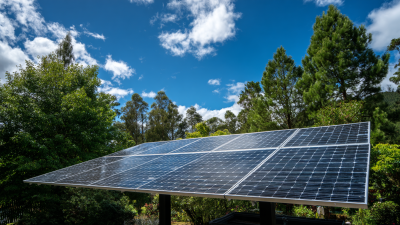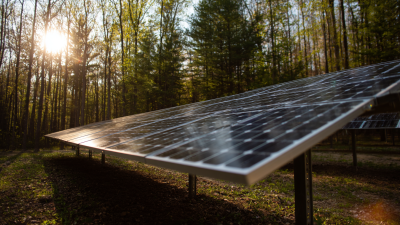A Comprehensive Guide to Choosing the Best Residential Solar Panels for Your Home
As the global transition towards sustainable energy continues to gain momentum, the demand for residential solar panels is at an all-time high. According to the Solar Energy Industries Association (SEIA), the U.S. residential solar market saw a remarkable 15% growth in 2022, with over 30 gigawatts of new capacity installed. This shift not only reflects growing environmental consciousness among homeowners but also highlights the long-term economic benefits of solar energy solutions.
By investing in residential solar panels, homeowners can reduce their monthly energy bills, increase their property value, and contribute to a cleaner planet for future generations. However, with numerous options available, choosing the best solar panels tailored to individual needs can be daunting. This comprehensive guide aims to simplify that process, helping you navigate the complexities of selecting the right residential solar panels for your home.

Understanding Solar Panel Types: Monocrystalline, Polycrystalline, and Thin Film Options
When selecting solar panels for your home, understanding the different types available is crucial. The three main categories are monocrystalline, polycrystalline, and thin film, each with its unique characteristics and benefits.

Monocrystalline panels are known for their high efficiency and sleek design. Made from a single crystal structure, they tend to occupy less space while generating more electricity, making them ideal for homes with limited roof area. However, they generally come at a higher price point, which can be a consideration for budget-conscious homeowners.
Polycrystalline panels, on the other hand, offer a more cost-effective solution. These panels are made from multiple crystal structures, resulting in a slightly lower efficiency rate compared to monocrystalline options. Despite this, polycrystalline panels are widely used and provide a good balance of performance and affordability. Lastly, thin film solar panels are the lightest and most flexible option. Although they have a lower efficiency, they perform better in high temperatures and shaded environments. This makes them suitable for unusual roof styles or specific locations where traditional panels might struggle. Each option has its strengths and weaknesses, so understanding these differences is key to making an informed choice for your solar energy needs.
Evaluating Solar Panel Efficiency Ratings: What Numbers Mean for Your Energy Needs
When selecting residential solar panels, understanding efficiency ratings is crucial for meeting your energy needs. Solar panel efficiency refers to the percentage of sunlight that the panels can convert into usable electricity. Higher efficiency ratings mean that more power can be generated from a smaller surface area, which is especially important for homeowners with limited roof space. For instance, panels with efficiency ratings above 20% are considered high-performance and can significantly contribute to reducing your electricity bill.

Additionally, it’s essential to take a closer look at the specific efficiency numbers provided by manufacturers. These ratings can vary significantly between brands and models, so comparing them is vital. Look for the performance metrics under Standard Test Conditions (STC), as this will provide a benchmark for evaluating how well the panels will perform under optimal sunlight. However, it’s also important to consider how panels perform in real-world conditions, including temperature and shading. Understanding these factors will help you make an informed decision on which solar panels align best with your household's energy requirements.
Assessing the Lifespan and Warranty of Residential Solar Panels: Industry Standards and Expectations
When considering the best residential solar panels for your home, understanding the lifespan and warranty of these products is crucial. Solar panels typically have a lifespan ranging from 25 to 30 years, during which time their performance gradually declines. This natural degradation means that while a solar panel may still function after three decades, it could operate at significantly reduced efficiency. Homeowners should anticipate this decline and choose solar panels known for robust longevity features.
In addition to lifespan, the warranty offered by solar panel manufacturers plays a vital role in long-term investment. Most reputable manufacturers provide warranties that cover performance and defects over 25 years, which is aligned with industry standards. A comprehensive warranty not only protects your investment but can also provide peace of mind as it reflects the manufacturer’s confidence in their product. Staying informed about the latest solar panel technologies and warranty structures will enable homeowners to make well-rounded decisions, ensuring they select a solution that promises reliability and efficiency for years to come.
A Comprehensive Comparison of Residential Solar Panels Based on Lifespan and Warranty
Calculating the Cost of Solar Panel Installation: Factors Influencing Pricing and ROI
When considering the installation of residential solar panels, understanding the costs involved is crucial for homeowners. Various factors significantly influence solar panel pricing, including system size, panel type, installation complexity, and even geographical location. According to the Solar Energy Industries Association (SEIA), the average cost of solar panel installation in the United States is approximately $3.00 to $4.00 per watt, which translates to around $15,000 to $25,000 for a typical home system, before any incentives or rebates.
Moreover, the return on investment (ROI) for solar energy can vary widely based on local electricity rates and available state incentives. A recent report from the National Renewable Energy Laboratory (NREL) indicates that homeowners can expect to recover their initial investment in solar within 5 to 10 years, depending on factors like energy consumption and utility costs. Additionally, with federal tax credits covering up to 30% of installation costs, the effective expenditure is significantly reduced. This financial landscape indicates that solar panels not only contribute to sustainable energy practices but also represent a solid long-term investment for many homeowners.
A Comprehensive Guide to Choosing the Best Residential Solar Panels for Your Home - Calculating the Cost of Solar Panel Installation: Factors Influencing Pricing and ROI
| Panel Type | Efficiency (%) | Cost per Watt ($) | Average Installation Cost ($) | Expected Lifespan (Years) | Estimated ROI (%) |
|---|---|---|---|---|---|
| Monocrystalline | 20-22 | 3.00 | 15,000 | 25 | 18 |
| Polycrystalline | 15-17 | 2.50 | 12,000 | 20 | 15 |
| Bifacial | 18-20 | 3.50 | 18,000 | 30 | 20 |
| Thin-Film | 10-12 | 1.00 | 8,000 | 15 | 10 |
Navigating Incentives and Rebates: Maximizing Financial Benefits for Your Solar Investment
When considering solar panel installation for your home, understanding the available financial incentives can make a significant difference in your investment. In 2025, New York is poised to offer a robust array of solar tax credits, rebates, and other financial incentives aimed at promoting renewable energy adoption. Homeowners can take advantage of these incentives to reduce the upfront costs associated with solar installations, making it more financially feasible to switch to clean energy. These programs are designed to empower homeowners by lowering their energy bills and contributing to overall sustainability efforts.
Additionally, the trend of third-party ownership (TPO) models has emerged as an effective strategy to encourage solar power adoption. With TPO, homeowners can install solar panels at little to no up-front cost while paying a fixed monthly rate that is typically lower than their previous energy bills. This model not only alleviates the financial burden but also aids in navigating the complex landscape of local incentives. As states enhance their solar programs, it’s crucial for homeowners to stay informed about potential rebates and tax credits that can maximize their investment in solar energy, ultimately leading to substantial savings in the long run.
Related Posts
-

7 Best Solar Panels for Maximum Efficiency in 2023
-

Unmatched Excellence in Home Solar Installation from Top Chinese Manufacturing厂商
-

Advantages of Choosing the Best Solar Panels for Sustainable Energy Solutions
-

10 Essential Tips for Sourcing Solar Panels Effectively in 2024
-

The Future of Sustainable Living with the Best Home Solar Panel System
-

Ultimate Guide to Choosing the Best Solar Energy Panels for Your Home